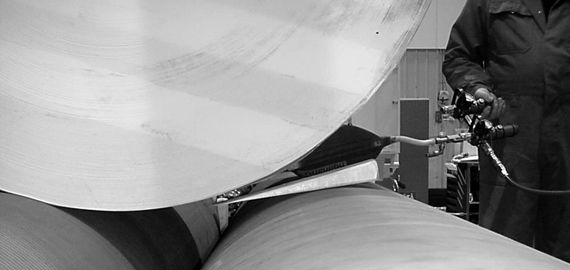Winder safety - releasing from a nip with a lifting cushion
May 17, 2016

 |
CAUTION: Rescue situations vary, therefore unambiguous operating instructions for every situation cannot be made. We recommend that rescue personnel try several different types of rescue equipment in order to determine the best possible equipment for each situation. |

Lifting devices for the shipping roll
Following is a list of some lifting devices which can be used for lifting the shipping roll from the winding drum. Each piece of the equipment has its limitations, so familiarize yourself with the possibilities and ways to use them.
- Lifting cushion
- Hydraulic spreader
- Wedges

Lifting cushion in operation above winder drums
Example of using the lifting cushion
The lifting cushion is a rescue device with which a person can be released from a nip between a shipping roll and the winding drum. With the aid of a lifting cushion, the shipping roll is lifted in order to release the part of the body that has been caught between the winding drum and the shipping roll.
This instruction describes one method of releasing a person from the nip between the winding drum and the shipping roll.
The thickness of an empty lifting cushion depends on the cushion type. The lifting capacity and height are described in the technical data of the lifting cushion.
The nip between the winding drum and shipping roll may be nearly closed at the beginning. In that case the shipping roll must be lifted multiple times with the aid of the lifting cushion. Wedges can also be used when lifting the shipping roll.

 |
CAUTION: The lifting force of a lifting cushion is very high. Misuse of a lifting cushion may cause personal injury or breakage of devices. Users must follow the instructions and warnings provided by the product manufacturer. |

Using the lifting cushion:
It is assumed that the trapped person has received first aid and new accidents are prevented.
1. Prevent the accidental start-up of the winder electric drive. Follow the instructions of the electric drive supplier.
2. Ensure that the winding drums do not rotate during lifting. For example, put wedges into the nip between the end of the winding drum and the bearing or ensure that the drum brakes are on.
3. Determine whether the devices have to be moved.

 |
CAUTION: Controlling the rider roll and core locks is prevented when the emergency stop function is on. The rider roll and core locks can, however, be forced upwards. |

If it is not necessary to move the devices
3a. Keep the emergency stop function on and do not acknowledge alarms in order to prevent an unexpected start-up.
If it is necessary to move the devices
3b. Acknowledge the emergency stop function and alarms. Be very careful and thoughtful when moving any device.
4. Position the lifting cushion on the side of the roll where the person is trapped. Insert the lifting cushion as deep into the nip between the shipping roll to be lifted and the winding drum as possible. If necessary, lift the roll from both sides.
5. Inflate the lifting cushion in a controlled manner. Inflating the lifting cushion may cause the shipping roll to swing in the wrong direction.
6. Put the wedges into the space caused by the lifting cushion between the shipping roll and the winding drum. The wedges ensure that the nip remains open.
7. When the nip between the shipping roll and the winding drum has been opened more than the thickness of the lifting cushion, but the trapped person can not yet be released, support the shipping roll so that it can not lower or swing. This ensures that the nip stays open when the lifting cushion is moved deeper into the nip for a new lift.
8. Deflate the lifting cushion and move it deeper into the nip.
9. Inflate the lifting cushion in a controlled manner. Ensure that the shipping roll does not lower or swing. By inflating the lifting cushion twice, the shipping roll is normally lifted high enough that the trapped person can be released from the nip. If necessary, continue to lift and wedge the shipping roll until the person can be released.
10. When the trapped person has been released, remove the rescue equipment carefully to prevent new accidents.
For more information on improving safety in the winding nip area, consult your mill's safety manager or contact your Valmet representative for training or safety rebuild options.